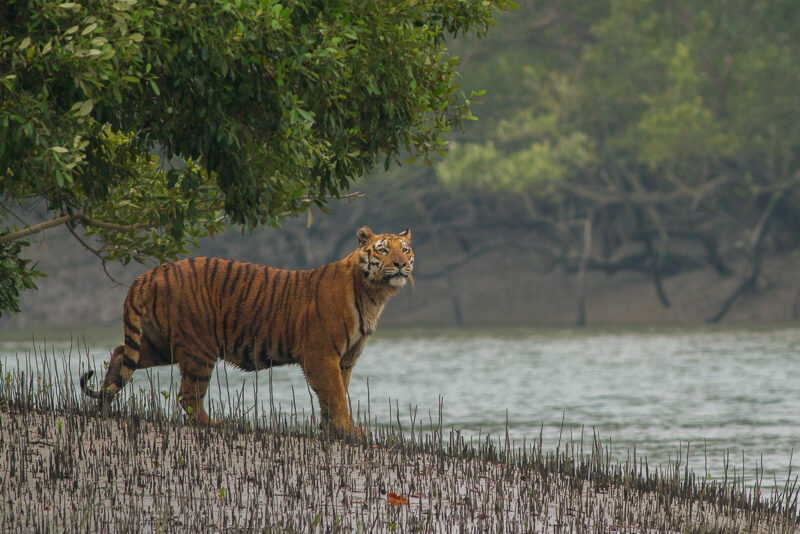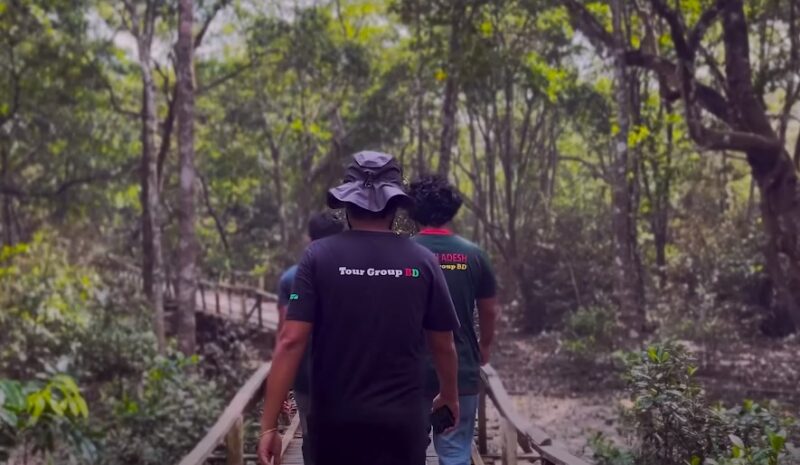
Seeing a Bengal tiger in the wild is an incredible experience, especially in the thick, green mangrove forests of the Sundarbans. This area, sitting between India and Bangladesh, is a paradise for wildlife lovers. If you’ve always wanted to see these amazing animals up close, this guide has all the info you need to make it happen.
Trust me, it’s an adventure you won’t forget.
While on the safari…
When you’re in the Sundarbans, use these tips to up your chances of seeing a Bengal tiger. Patience and sticking with it are crucial because wildlife sightings can be pretty hit-or-miss.
It’s the early mornings and late afternoons
Tigers are most active in the early mornings and late afternoons. Plan your safaris around these times for a better shot at spotting one. The cooler temps and dimmer light make it easier for tigers to roam and hunt. Plus, you’ll see other wildlife being more active too, which makes the whole experience even better.
Be silent…
When you’re on a safari, keep things quiet. Tigers have super sharp hearing and can get scared off by loud noises. Your guide will show you how to communicate without making too much noise. Try to avoid sudden movements and loud sounds because they can spook the tigers and other animals.
Look for signs
Guides are pros at spotting signs that a tiger is nearby. Keep an eye out for pugmarks (that’s tiger footprints), scratch marks on trees, and alarm calls from other animals. When animals like deer and monkeys make alarm calls, it usually means a predator is around. Fresh pugmarks in the mud or on trails are a big clue that a tiger was recently in the area.
Everything you need to know about the Habitat

The Sundarbans, a UNESCO World Heritage Site, is famous for its incredible biodiversity. This vast mangrove forest, covering around 10,000 square kilometers, is the perfect home for the Bengal tiger. The unique ecosystem here supports all kinds of wildlife, but let’s be real—it’s the tigers that steal the show.
With dense vegetation and a complex network of waterways, it’s like a tiger’s playground, making hunting and hiding a breeze. The mix of tidal currents and the forest’s unique plants makes the Sundarbans a true ecological treasure.
Watch out for the mangrove maze
Getting around the Sundarbans isn’t a walk in the park. It’s a maze of tidal waterways, mudflats, and little islands. The mangroves are crucial for many species, especially the Bengal tiger, which uses the dense forest as cover while hunting.
This labyrinth not only provides the tigers with a perfect hunting ground but also makes it tough for intruders to get around, keeping the tigers safe from human threats. The tangled roots and branches create natural paths and hiding spots, essential for both predators and their prey.
Climate and seasons
The best time to visit the Sundarbans is during the winter months, from November to February. The weather is cooler, and your chances of spotting wildlife, including tigers, are much higher. Monsoon season, from June to September, brings heavy rains and swollen rivers, making travel difficult.
In winter, lower water levels and clearer skies make for better wildlife viewing. Plus, the cooler temperatures make exploring the dense forest a lot more comfortable.
In contrast, the monsoon season not only brings heavy rainfall but also increases the risk of running into dangerous reptiles like snakes.
Meet the Bengal tiger

The Bengal tiger is one of the most famous and endangered animals in the world. In the Sundarbans, these tigers are known for their incredible swimming skills and unique adaptations to the mangrove forests.
These tigers are often larger than their counterparts elsewhere, probably because of the rich diet they enjoy in the Sundarbans. Their swimming abilities are essential for navigating the countless waterways, which helps them hunt and mark their territory. They’ve even adapted to tolerate the brackish water of their unique environment.
What they look like
Bengal tigers are truly impressive. Male tigers can weigh up to 250 kg (550 lbs) and can be about 3 meters (10 feet) long from head to tail. Their orange coat with black stripes provides excellent camouflage in the dense forest, making them tough to spot.
This camouflage works wonders in the mangrove forest, where light and shadows blend perfectly. Their muscular build and sharp claws make them formidable hunters, able to take down large prey. Their keen sense of hearing and sight also help them stalk and ambush prey effectively.
How they live and hunt
Tigers in the Sundarbans are solitary and very territorial. They are fantastic swimmers, often crossing rivers and creeks in search of food. Their diet includes deer, wild boar, and sometimes fish. They are most active during dawn and dusk, the best times to spot them.
Their hunting strategy relies on a mix of stealth and power, often ambushing prey with a swift, powerful pounce. Because they are so solitary, seeing one in the wild is a unique and rare experience. They mark their territory with scent and scratch marks on trees to communicate with other tigers.
How to plan your trip

Planning is crucial for a successful wildlife adventure in the Sundarbans. Here are some straightforward tips to help you get ready. Good preparation not only makes your trip more enjoyable but also keeps you safe and compliant with local rules. A well-thought-out plan can turn a potential wild goose chase into an amazing wildlife encounter.
Pick the right tour operator
Find a tour operator with a solid reputation and experience in Sundarbans wildlife safaris. Look for those offering guided tours with knowledgeable naturalists—they can really boost your chances of spotting a tiger. These guides know the tigers’ habits and the best spots for sightings.
Plus, they’ll share interesting facts about the local plants and animals, making your trip even more enriching. Make sure the operator practices ethically and respects the environment.
Get your permits and follow the rules
You need permits from the forest department to visit the Sundarbans. Make sure all your paperwork is sorted before you go. Following the regulations is key to protecting the delicate ecosystem and its wildlife. Permits are often required to enter specific zones and are usually limited to a certain number of visitors each day to reduce environmental impact.
Check the latest requirements and get your permits well in advance. Sticking to these rules helps conservation efforts and keeps both you and the wildlife safe.
Make sure to pack the essentials
Pack light but include essential items such as:
- Binoculars: Trust me, you’ll want a good pair to spot wildlife from a distance. They make all the difference when trying to see those elusive animals hiding in the thick foliage.
- Camera: Bring one with a good zoom lens to capture those once-in-a-lifetime moments. A waterproof camera or casing is a smart move since it can get pretty wet out there.
- Clothing: Go for light, breathable fabrics in neutral colors to blend in with the surroundings. Long sleeves and pants are great for protecting against insect bites and sunburn.
- Insect repellent: The mangroves are full of bugs, especially mosquitoes. A good insect repellent will keep you bite-free and comfortable.
- Sunscreen and hat: The sun can be brutal, even in the forest. Slather on some sunscreen and wear a hat to protect yourself from those harsh UV rays. You’ll enjoy your trip a lot more without the discomfort of sunburn.
How to stay safe

Spotting a Bengal tiger in the wild is incredibly thrilling, but safety has to come first. Here are some straightforward tips to keep your adventure safe and fun.
Listen to your guide
Your guide knows their stuff. They’re trained to handle wildlife encounters and understand animal behavior. Always listen to what they say. They’re there to keep you and the animals safe. Trust them—they can navigate tricky situations and prevent accidents, making sure your interaction with nature is respectful and safe.
Keep your distance
Tigers are wild and unpredictable. Keep your distance and never try to approach or provoke them. Watching a tiger from afar is just as awe-inspiring, if not more so. Staying back protects both you and the tiger. Binoculars or a zoom lens can give you a closer view without putting anyone at risk.
Respect the environment
Don’t litter or mess up the habitat. The Sundarbans is a protected area, and its health is vital for the animals living there. Take all your trash with you and dispose of it properly. Be careful not to damage plants or disturb the wildlife.
All in all…
Get ready for an unforgettable wildlife adventure in the Sundarbans. The thrill of seeing a Bengal tiger in its natural habitat is an experience you won’t want to miss
Related Posts:
- A Day in the Life of Chittagong - What You Can't Miss
- Patenga Beach - All You Need to Know Before You Go
- How I Experienced the World's Largest Mangrove…
- Why Is Bay of Bengal Famous? - For Travelers,…
- 12 Best Resorts in Gazipur, Dhaka 2023 - From Luxury…
- Top 13 Cultural Festivals in Bangladesh - When and…














